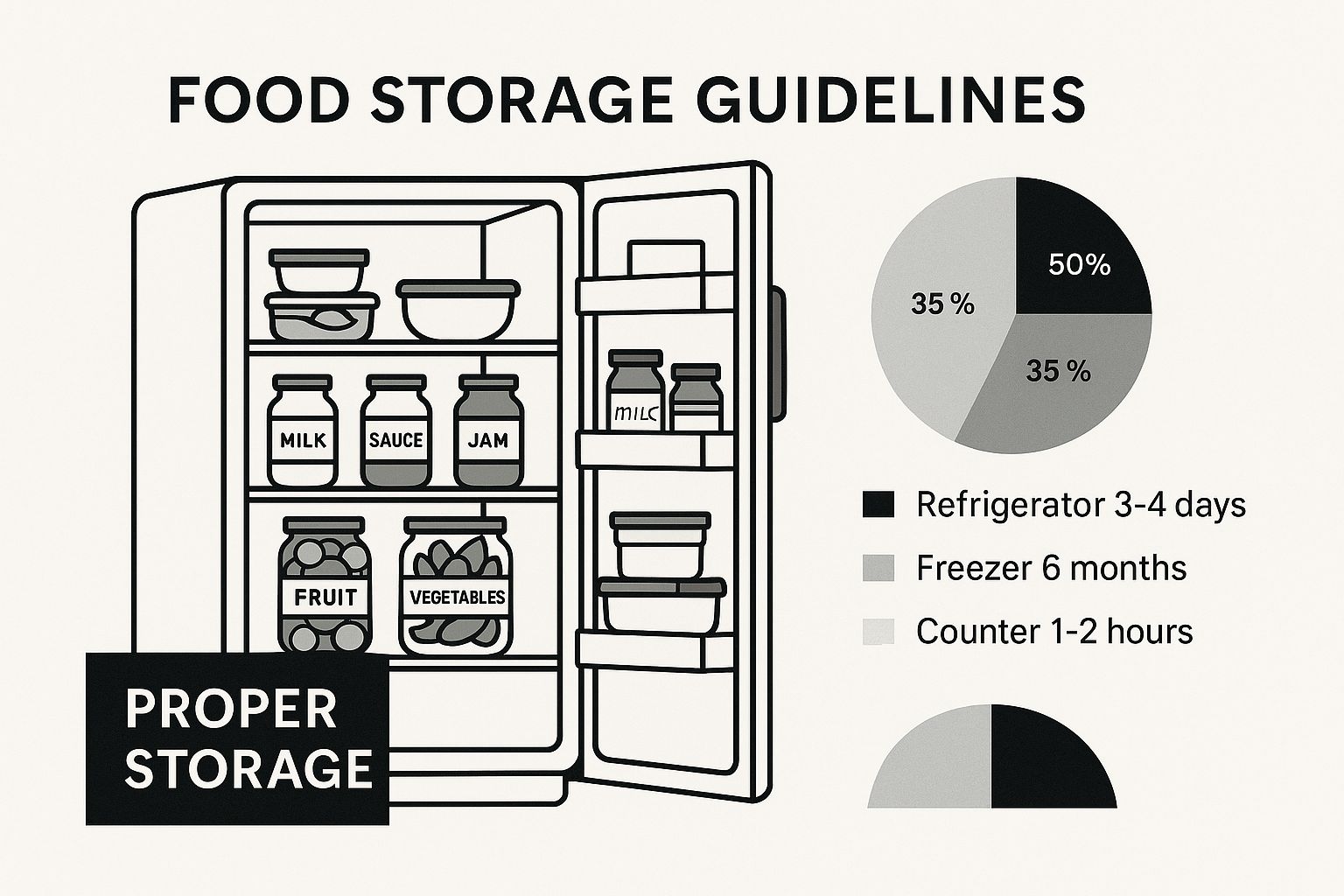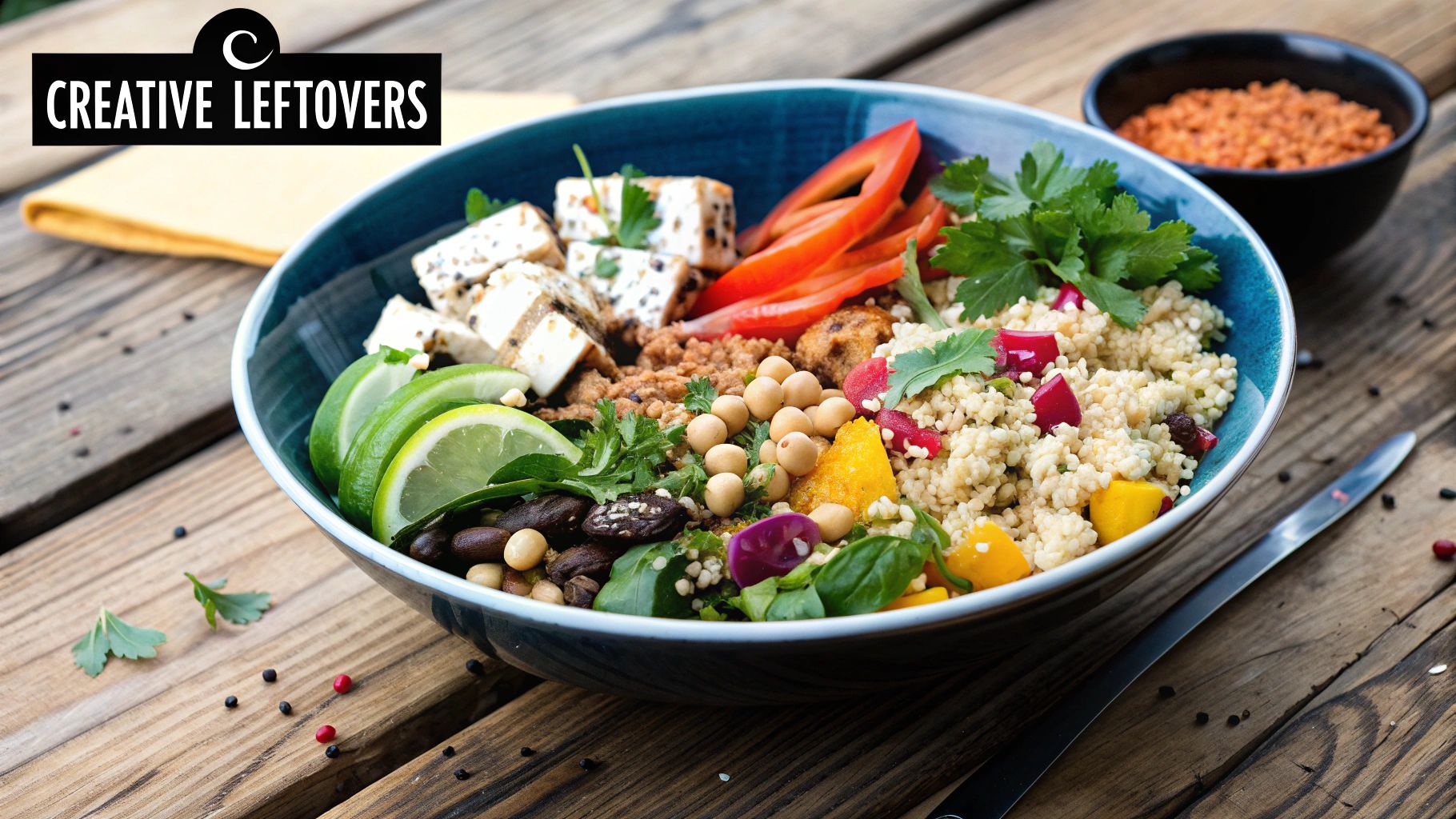Understanding the Real Impact of Food Waste
Discarded food is more than just a minor household annoyance. It’s a serious environmental problem with far-reaching consequences. The food we throw away contributes to a range of global issues, affecting everything from the climate to our precious natural resources. Recognizing this connection is the first step toward learning the best ways to minimize food waste and create a more sustainable kitchen.
The Environmental Footprint of Food Waste
Food waste carries a surprisingly large carbon footprint. Consider the resources required for food production: water for irrigation, land for farming, and energy for processing and transportation. When food is discarded, these valuable resources are wasted as well. This contributes to deforestation, water scarcity, and a rise in greenhouse gas emissions. For example, producing a single hamburger requires a substantial amount of water, all of which is wasted if the burger ends up in the trash.
Food decomposing in landfills releases methane, a potent greenhouse gas significantly more harmful than carbon dioxide. This further intensifies climate change and its related consequences, such as rising sea levels and extreme weather events. Minimizing food waste is, therefore, a crucial part of addressing climate change.
Wasted food also represents a loss of biodiversity. Modern agriculture often relies on monoculture farming, which reduces the variety of crops grown and can negatively impact ecosystems. When food is wasted, so is the biodiversity that could have supported a healthier planet.
The Staggering Statistics of Food Loss
The sheer scale of food waste is truly alarming. Reducing food waste offers substantial global environmental benefits, as food loss and waste currently account for 8–10% of annual global greenhouse gas emissions. This figure is about five times higher than the total emissions from the aviation sector.
In 2022, the UN Environment Programme (UNEP) documented that 19% of all food available to consumers was wasted at the retail, food service, and household level. An additional 13% is lost in the supply chain, according to the FAO. This means that over one-third of the food produced globally never makes it to our plates. This is not only environmentally irresponsible but also economically unsustainable.
From Global Impact to Personal Responsibility
While the global implications of food waste can feel overwhelming, individual actions can make a real difference. Small changes in our kitchen habits, much like small changes in our daily routines, can contribute to a healthier planet. By understanding the link between our food choices and the environment, we can become more conscious consumers and reduce our environmental impact, one meal at a time. This understanding lays the groundwork for exploring practical ways to minimize food waste in our kitchens.
Smart Shopping Strategies That Actually Work
Preventing food waste begins with smart shopping. By adopting strategic shopping habits, you can significantly reduce waste before it even enters your home. This not only saves money but also minimizes environmental impact and simplifies meal preparation.
Planning Your Purchases
One of the most effective ways to minimize food waste is meal planning. Create a weekly menu based on ingredients you already have and what you need to purchase. This helps you avoid impulse buys and ensures you only buy what you intend to use.
Shopping lists are crucial for sticking to your meal plan. Organize your list by grocery store sections to save time and avoid distractions. Before heading to the store, “shop your fridge” to see what you already have and prevent duplicate purchases.
Navigating the Grocery Store
Grocery stores are designed to encourage spending, but strategic shoppers can resist these tactics. Avoid bulk buying unless you’re sure you can use the entire quantity before it spoils. Consider freezing portions of bulk items to extend their shelf life.
Understanding expiration dates is also important. “Best by” dates indicate peak quality, while “use by” dates refer to safety. Many foods remain safe to consume after the “best by” date, so use your best judgment.
Making Informed Choices
Consider the storage requirements of different foods when shopping. Purchase produce that ripens at different rates to prevent everything from spoiling at once. Choose storage-conscious packaging, such as reusable containers, to keep food fresh for a longer period.
This infographic illustrates the impact of proper storage. The image of neatly organized containers and labeled jars within a refrigerator visually demonstrates how efficient storage can help maintain food freshness and reduce waste.
Proper storage, as shown in the infographic, is key to a waste-reduction strategy. Using containers, labels, and strategic organization helps you keep track of your food, easily identify what needs to be used, and prevent spoilage due to neglect.
To better understand the differences between a traditional and strategic approach, let’s look at a comparison:
Shopping Methods Comparison: Traditional vs Strategic Approach
| Shopping Method | Average Weekly Cost | Time Investment | Waste Reduction | Family Satisfaction |
|---|---|---|---|---|
| Traditional | $150 | 1 hour | Low | Moderate |
| Strategic | $120 | 1.5 hours (initial planning), then 30 minutes | High | High |
As you can see, while the initial time investment for strategic shopping may be slightly higher due to planning, it ultimately saves money and significantly reduces waste, leading to increased family satisfaction.
Seasonal and Local Shopping
Buying seasonal produce has numerous advantages. Seasonal fruits and vegetables are typically fresher, tastier, and less expensive. They also have a lower environmental impact because of shorter transportation distances.
Supporting local farmers’ markets is another way to reduce waste. Locally grown produce is generally harvested closer to peak ripeness, extending its shelf life at home. Farmers’ markets offer opportunities to purchase “imperfect” produce that supermarkets might otherwise discard, making this a cost-effective way to obtain fresh produce and reduce waste.
Adapting to Your Lifestyle
Smart shopping strategies should be adapted to individual needs and lifestyles. Consider your family size and dietary preferences when planning meals and making shopping lists. If you live alone, purchase smaller quantities or freeze portions to prevent spoilage. For specific dietary needs, choose products that align with those requirements and minimize waste accordingly.
By incorporating these smart shopping practices, you can significantly reduce food waste at the source. This creates a more sustainable kitchen and reduces the need for complex waste management solutions in the long run. Small changes in shopping habits can have a substantial impact in the fight against food waste.
Mastering Food Storage Like a Professional
Proper food storage is crucial for minimizing food waste. Smart shopping helps you choose the right foods, but proper storage keeps them fresh longer. This means less food goes in the trash, saving you money and reducing your environmental impact. Let’s explore some professional-grade storage techniques that are easy to implement at home.
Refrigerator Organization: A Science-Backed Approach
Refrigerators have different temperature zones. Understanding these zones is key to proper food storage. The door, the warmest part, is best for condiments and less perishable items. The lower shelves, the coldest, are ideal for raw meat, poultry, and fish. This placement prevents cross-contamination and keeps perishables safe.
Storing fruits and vegetables also requires some knowledge. Some produce, like apples and bananas, release ethylene gas, which accelerates ripening in nearby produce. Store these separately. Leafy greens stay crisp longer when stored in slightly damp paper towels. This simple trick can significantly extend their lifespan.
Freezing: Your Secret Weapon Against Food Waste
Freezing preserves food for extended periods. However, using the right techniques is important. Blanching vegetables before freezing helps maintain their color, texture, and nutrients. Portioning food into freezer-safe containers or bags prevents freezer burn and allows you to thaw only what you need, reducing waste.
Natural Preservation Methods and Beyond
Beyond refrigeration and freezing, other preservation methods can extend the life of your food. Pickling, fermenting, and drying are time-tested techniques that not only preserve food but also add unique flavors. Pickling cucumbers, for instance, increase their shelf life and add a tangy kick. These methods let you enjoy seasonal produce year-round.
Innovative storage solutions like vacuum sealers and reusable wraps provide modern approaches to food preservation. Vacuum sealing removes air, slowing oxidation and extending shelf life. Reusable wraps, often made from beeswax or silicone, offer a sustainable alternative to plastic wrap. To maximize your grocery budget and minimize waste, consider effective meal planning and grocery list strategies.
Debunking Storage Myths
Many common storage myths can actually lead to faster spoilage. Storing tomatoes in the refrigerator diminishes their flavor and texture. Potatoes should be stored in a cool, dark place, but not the refrigerator, as cold temperatures can convert starches to sugars. Understanding these nuances helps you maximize the lifespan and quality of your food, minimizing waste and maximizing your grocery budget. Implementing these professional storage techniques can dramatically reduce household food waste by up to 40%.
Creative Approaches to Leftovers and Food Scraps
Transforming leftovers from a dreaded chore into a culinary adventure is easier than you think. Resourceful cooks have long embraced creative ways to minimize food waste, turning potential trash into delicious new meals. This approach not only saves money but also reduces your environmental impact.
Batch Cooking and Planned Leftovers
One effective way to minimize food waste is batch cooking. Prepare larger quantities of staples like rice, beans, or roasted vegetables, then portion and freeze them for future use. This simplifies weeknight meals and ensures ingredients are used efficiently.
Plan your meals strategically. For example, roast a whole chicken on Sunday, then use the leftover meat in salads, sandwiches, or tacos throughout the week. This saves cooking time and maximizes the value of each ingredient.
From Scraps to Stars: Creative Recipes
Often discarded, vegetable scraps like carrot tops, onion peels, and herb stems can create flavorful stocks and broths. These additions bring depth and richness to soups, stews, and sauces.
Wilted produce can be revived with simple techniques. Submerge limp greens in ice water to restore crispness. Overripe fruit is perfect for smoothies or baked goods. Even stale bread can be reborn as croutons, breadcrumbs, or French toast.
Fusion Fun: Reinventing Leftovers
Combine different leftover elements into new dishes. Leftover cooked chicken and vegetables can become the filling for quesadillas or a hearty stir-fry. This fusion approach helps prevent “leftover fatigue.”
Composting: Nature’s Recycling System
For truly unusable scraps, composting offers a natural way to recycle food waste. Composting breaks down organic matter, creating nutrient-rich soil for gardens or houseplants. This reduces landfill waste.
Beyond the Plate: Alternative Uses for Food Scraps
Some food scraps can even be used for cleaning. Citrus peels can create a natural cleaning solution. Coffee grounds can deodorize refrigerators or scrub stubborn stains. These uses extend the value of your food.
Building a Sustainable Kitchen Routine
By adopting these creative approaches, you can transform your kitchen. Minimizing food waste becomes a rewarding process, leading to delicious meals and a healthier planet. Start small, experiment, and enjoy the journey towards a more sustainable kitchen.
The Hidden Economics of Food Waste
Understanding the true cost of food waste can be surprising. We often don’t realize how much discarded food impacts our finances. Let’s explore the financial implications of food waste and discover how reducing it can lead to significant savings.
The Cost of Wasted Groceries
The average household loses a significant amount of money each year due to thrown-away food. This loss can be comparable to other major household expenses, like utilities or transportation. By reducing food waste, families can free up money for other things, whether it’s a family vacation or adding to their savings. Even redirecting a small portion of that wasted food budget can make a difference.
Analyzing waste patterns across different income levels and family sizes offers interesting perspectives. Larger families, for example, might encounter different challenges in minimizing waste. By understanding their consumption habits, these families can pinpoint areas for improvement and achieve substantial savings. This personalized approach makes waste reduction strategies more effective and sustainable.
Business Practices: Profitability and Sustainability
Smart businesses understand that minimizing food waste is not only environmentally responsible but also financially beneficial. Restaurants, for instance, can cut costs and boost profits by implementing effective inventory management and optimizing portion sizes.
This strategy reduces waste while maximizing the value of each ingredient. For businesses looking to improve their sustainability practices, choosing eco-friendly takeout containers is a great step. This resource helps businesses select packaging that aligns with waste-reduction goals.
Community Impact: Sharing the Surplus
Many community programs redirect surplus food to those who need it most. Food banks and similar organizations collect edible but unsold food from grocery stores and restaurants, distributing it to families experiencing food insecurity. This not only reduces food waste but also helps strengthen communities. In the United States, food waste is a major issue, making up the largest category of materials in landfills. It accounts for 24% of all landfilled waste and 22% of incinerated solid waste as of 2018. The US discards almost 40% of its entire food supply – approximately 60 million tons each year – despite efforts to manage waste through composting, donation, and animal feed.
Real-World Success Stories: Inspiration for Change
Learning from families and organizations that have successfully reduced food waste can be inspiring. These success stories show that significant change is achievable. They offer practical strategies that others can adapt to their own situations. One family, for instance, decreased their weekly food waste by 75% simply through meal planning and composting.
Calculating Your Potential Savings
Think about the cost of the food you typically throw away each week. Multiply that number by 52 to estimate your potential annual savings. This simple calculation can be quite revealing, highlighting the financial advantages of reducing food waste. Imagine what you could do with that extra money. These potential savings provide a tangible incentive to make lasting changes in our kitchen habits.
From Waste to Wealth: A Mindset Shift
Minimizing food waste involves changing how we think about discarded food. Instead of seeing it as trash, we need to recognize its potential value. By adopting a more resourceful approach, we can unlock the hidden economics of food waste and make our kitchens more sustainable and financially responsible. This shift encourages a more mindful relationship with our food and resources, benefiting both our wallets and the environment.
Technology Solutions for Modern Food Management
Technology offers innovative approaches to minimizing food waste, going beyond traditional methods. From smart refrigerators to mobile apps, technology changes how we manage food, both at home and in businesses. This makes reducing food waste more accessible and efficient.
Smart Home Devices and Applications
Several apps help track food expiration dates, suggest recipes based on available ingredients, and even connect you with neighbors to share excess food. Imagine your refrigerator alerting you when milk is about to expire, or an app creating a shopping list based on what’s in your pantry. These tools empower informed decisions about your food, reducing spoilage. For example, some apps scan grocery receipts and automatically add items to a virtual inventory, sending notifications as expiration dates near.
Emerging Technologies: Sensors and AI
Smart sensors monitor food freshness in real time. These sensors detect changes in temperature, humidity, and even the food’s chemical composition, providing precise information about its condition. This allows for more accurate expiration date tracking and prevents spoilage by alerting you to potential issues. AI-powered inventory management systems are also becoming more sophisticated, helping businesses optimize stock levels and minimize waste. These systems analyze data to predict demand and optimize purchasing, which helps minimize excess stock.
Blockchain for Transparency and Traceability
Blockchain technology plays a role in reducing food waste. By creating a transparent and traceable record of food throughout the supply chain, blockchain can help identify points of loss and inefficiency. This allows businesses to pinpoint waste and implement targeted solutions. This transparency also helps consumers make more informed choices, supporting businesses that prioritize waste reduction.
Data Analytics and Satellite Monitoring
Major food companies use data analytics and satellite monitoring to identify waste sources on a large scale. By analyzing supply chain data, companies can identify patterns and trends in food waste and develop effective solutions. Satellite imagery can monitor landfill methane emissions, providing data on food waste’s environmental impact.
Globally, over a third of all food produced—about 2.5 billion tons—is lost or wasted each year, valued at around $230 billion according to the Boston Consulting Group (BCG). Data-driven initiatives in 2025, like the U.S. Food Waste Pact and enhanced satellite monitoring of landfill methane emissions, are helping to pinpoint waste sources and track progress. These initiatives pave the way for more targeted and effective waste reduction strategies.
Technology’s Role in a Sustainable Future
These technological advancements create new opportunities for individuals, businesses, and communities to reduce food waste. By embracing these innovations, we can move toward a more sustainable food system that minimizes waste, conserves resources, and benefits both the environment and our budgets. These tools empower us to make informed decisions about our food and its environmental impact.
Food Waste Reduction Technologies and Their Impact
| Technology Type | Implementation Cost | Waste Reduction Potential | Ease of Use | Best For |
|---|---|---|---|---|
| Mobile Apps | Low | Moderate | High | Households, Individuals |
| Smart Sensors | Moderate | High | Moderate | Businesses, Large-Scale Operations |
| Blockchain | High | High | Low | Supply Chain Management |
| AI-Powered Inventory Systems | Moderate to High | High | Moderate | Businesses, Restaurants |
These technological tools are not just passing trends; they represent a crucial shift toward more mindful and responsible food management. Integrating these technologies into daily life and business operations allows us to contribute to a more sustainable future.
Key Takeaways
Proper maintenance is crucial for everything in your kitchen. Just as regular upkeep keeps fitness equipment safe and functional, mindful food handling and storage can maximize the lifespan of your groceries. This guide provides practical strategies and steps for transforming your food waste habits.
Plan Before You Shop
Minimizing food waste begins with a well-thought-out shopping list. Meal planning is the cornerstone of this process. Create a weekly menu to guide your purchases, ensuring you only buy what you’ll use. Before heading to the grocery store, take inventory of your refrigerator and pantry to avoid buying duplicates. An organized shopping list, categorized by store sections, can help maintain focus and prevent impulse buys.
Smart Storage Is Essential
Proper storage is paramount after bringing groceries home. Refrigerator organization should prioritize food safety. Store raw meats, poultry, and fish on the bottom shelves to prevent cross-contamination. Be mindful of ethylene-producing fruits and vegetables, such as apples and bananas, and store them separately to avoid hastening the ripening of other produce. Simple techniques like wrapping leafy greens in slightly damp paper towels can significantly extend their freshness. By implementing these storage strategies, you can reduce household food waste by up to 40%.
Freezing and Preservation: Extend the Life of Your Food
Freezing is a powerful weapon in the fight against food waste. Blanch vegetables before freezing to preserve their quality and nutrients. Proper portioning into freezer-safe containers helps prevent freezer burn and allows for thawing only the needed amount. Beyond freezing, explore natural preservation methods like pickling, fermenting, and drying. These techniques not only preserve food but can also add depth and variety to your meals.
Leftovers: Culinary Goldmine, Not Kitchen Burden
Leftovers present endless culinary opportunities. Batch cooking simplifies meal preparation and reduces waste by allowing you to cook larger quantities and portion them for later use. Leftover roasted chicken can be transformed into salads, tacos, or sandwiches throughout the week. Often-discarded vegetable scraps can create flavorful stocks and broths. Even stale bread can find new life as croutons or breadcrumbs.
The Economic Advantage of Waste Reduction
The financial benefits of reducing food waste are substantial. The average family can save a significant amount each year simply by minimizing discarded food. This equates to a bonus at year’s end, solely through increased kitchen mindfulness. These savings could be redirected towards other expenses or used to enjoy something special.
Technology’s Role in Waste Management
Technology offers valuable assistance in waste management. Apps that track expiration dates, suggest recipes based on available ingredients, or connect you with neighbors to share surplus food provide modern solutions. Explore these technological options to streamline kitchen management and minimize waste.
Family Involvement and Accountability
Making waste reduction a family affair enhances its effectiveness. Involve everyone in meal planning, shopping, and storage. A visual tracking system can help monitor waste and celebrate successes. This collaborative approach fosters lasting habits and makes sustainability a shared responsibility. Even small changes can create a ripple effect, benefiting both your household and the environment.
Connecting With Your Community
Explore local resources and initiatives that support food waste reduction. Connect with food banks and community gardens to donate surplus food or learn about composting. Sharing knowledge and resources amplifies individual efforts, creating a greater impact within the community.
By implementing these strategies, you’ll be well on your way to minimizing food waste, saving money, and contributing to a more sustainable future. Start small, remain consistent, and enjoy the benefits of a waste-conscious kitchen.
Ready to make your takeout and delivery services more sustainable? Explore eco-friendly packaging options at MrTakeOutBags.com. From biodegradable containers to compostable cutlery, they offer solutions to help businesses minimize their environmental impact and enhance their brand image.






Comments are closed.